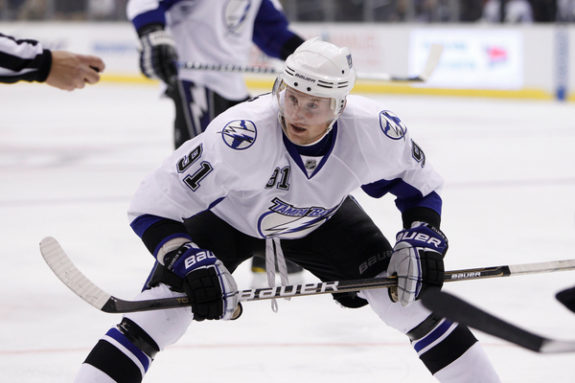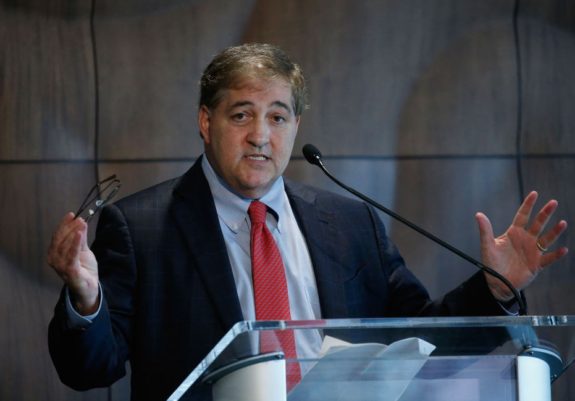With the Stanley Cup Final in the rearview mirror, all focus goes into offseason mode. While the Tampa Bay Lightning have already been active, the hockey world sits on the edge of its seats waiting to see what happens with their longtime superstar Steven Stamkos.
This could be it after 16 years and more than 1,000 regular-season games. If that’s the case, it’s been a ride. As we enter what could be the final days of Stamkos being a member of the Lightning, let’s look back at how far things have come since he arrived. The game of hockey and the Lightning as an organization have grown substantially since he came to Tampa Bay.
Stamkos’ Hard Times After Brief Success
The later years of the 2000s were an awkward time for the Lightning. Halfway through the decade, they were Stanley Cup champions and had made the playoffs in four consecutive seasons, with the lockout-canceled 2004-05 season smack in the middle.
It all came to an end following the loss in six games to the New Jersey Devils in the 2007 Conference Quarterfinal. In theory, it was supposed to be an exciting time. The Lightning had a rebrand to usher in the new Reebok Edge era of NHL jerseys. They would also be getting a new owner (from ‘MacLean part of group that has agreed to buy Lightning,’ The Columbus Dispatch, Aug 7, 2007).
However, turmoil came fast and the Lightning found themselves at the bottom of the NHL standings. Head coach John Tortorella was let go at the end of the season, and the potential new ownership deal fell apart due to internal strife.
Even when the teams had good times on the ice, there were still issues behind the scenes. The team bled money.
The Oakland Press had the following to say about Bill Davidson’s ownership of the team: “The one thing Davidson couldn’t do, though, was make the Lightning profitable” (from ‘Bill Davidson’s Palace Sports to sell Tampa Bay Lightning,’ The Oakland Press, Aug 7, 2007).
Related: Lightning: 5 Best Yzerman-Era Draft Picks
They couldn’t turn a profit despite the new attendance highs during those playoff years. Even when they were good, the team wasn’t packing the arena outside of the season they were defending champions.
It was a shaky time for the franchise, and the Lightning needed something to change their fortunes. Fortunately, they had an answer with the first-overall pick in the 2008 NHL Draft.
The Star Without an Audience
The Lightning drafted Stamkos on June 20, 2008. Expectations were high. Out of the gate, the Tampa Bay Times published his photo with the caption in big white, bold letters, “The Chosen One” (from ‘The Lightning makes Steve Stamkos the top pick, and star Vinny Lecavalier won’t wait long to take him under his wing,’ Tampa Bay Times, June 21, 2008).
Just to point out, this was not front-page news. Nowadays, it would be, but in 2008, this news was relegated to the part of a page in the sports section. Tampa Bay was a football market caught up in their baseball team being good for the first time. The attention wasn’t going to a rookie hockey player. Oh, how times have changed.

Perhaps Stamkos would catch everyone’s attention once he got on the ice. Lightning great Vincent Lecavalier was ready to help him develop, and Stamkos was ready to learn from him. That attention didn’t come right away. Stamkos had a respectable rookie season with 46 points in 79 games. Unfortunately, the Lightning didn’t improve much on the ice — they finished 24-40-18 with 66 points — and attendance was mediocre due to a combination of poor performance the season prior and that current season.
They replaced their new head coach, Barry Melrose, 16 games into the season with Rick Tocchet, and other new acquisitions to put a team around Stamkos, Lecavalier and Martin St. Louis didn’t help much.
Okay, but that was year one. Surely, the hype would start to catch on. Still no. The Lightning improved on the ice in 2009-10. Stamkos had his breakout season, leading the league in goals (51) to take home his first Maurice “Rocket” Richard Trophy. He also played his first season with defenseman Victor Hedman, who the Lightning drafted second overall in the 2009 Draft.
However, attendance only got worse, reaching a low point of 15,497 fans per game.
While they had a star, the Lightning had very little else at the time to win people over. Management at the time was struggling to build a quality product. It really looked like for a time a star would come to the area and go nearly unnoticed.
Patience would run out, especially when the Lightning were sold yet again to new ownership.
Under New Management
During Stamkos’ second season, the Lightning were sold to Boston hedge fund manager Jeffrey Vinik. For the first time ever, the team would have an owner dedicated to hockey and with the resources to make something happen.
“Buying the Lightning and joining the Tampa Bay community is a dream come true,” Vinik said following the purchase. “I’ve been an avid hockey fan my whole life, and I pledge to our fans that I will work my hardest to build the Lightning into a world-class organization both on and off the ice.”

Vinik quickly showed how serious he was about bringing change to the team. After the season, he cleared house and brought in new front office management, hiring Steve Yzerman to be the general manager. Over the next few years, Amalie Arena got some major renovations and the Lightning installed a brand new video board showing their commitment to a better experience (from ‘Tampa Bay Lightning’s new scoreboard will be picture perfect,’ Tampa Bay Times, July 15, 2012). They also installed Tesla coils to have Lightning bolts strike in the arena.
Stamkos would be the player the experience and team would be built around.
On the ice, the Lightning turned their performance around immediately with a trip to the Eastern Conference Final in 2010-11. Fans immediately came back and they never left. Stamkos was now playing in front of growing crowds, an upgraded arena, and a better team around him.
After the first couple years of Stamkos’ time in Tampa Bay, there was a clear shift in focus. While there was still an emphasis on building a good team, there was also a focus on making being at the game a full experience. The exposure also grew substantially. Soon, locals couldn’t go very far without seeing a Lightning logo or the face of a player on the team. They saw banners on the walls of high schools, city bikes with logos on them and players’ images in malls.
Fast-forward to the summer of 2024, and Stamkos is now one of the most beloved figures in Tampa Bay playing in front of sellout crowds. The era of being low-priority news and playing in front of weak attendance is far in the review mirror. In 2010, he could have left and many wouldn’t have known he was even there. Now, if he ends up leaving, it would leave the community in shock after years of continuity.
When Stamkos arrived, the Lightning had their niche, but didn’t play in a hockey market. Now, they look to re-sign him to keep in what has grown into a bona fide hockey market. They owe it to Stamkos to ensure he plays his whole career in the city and region he helped teach to love the game.
